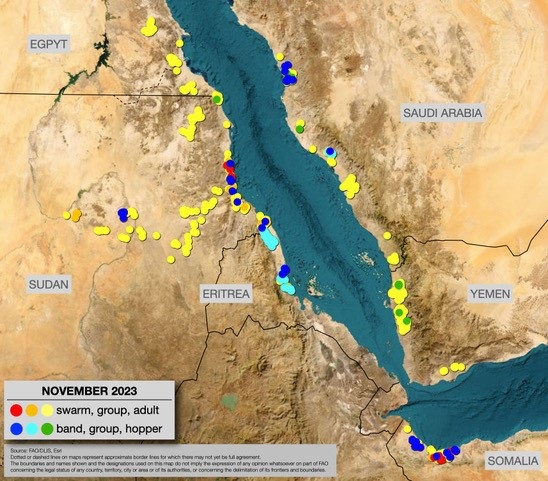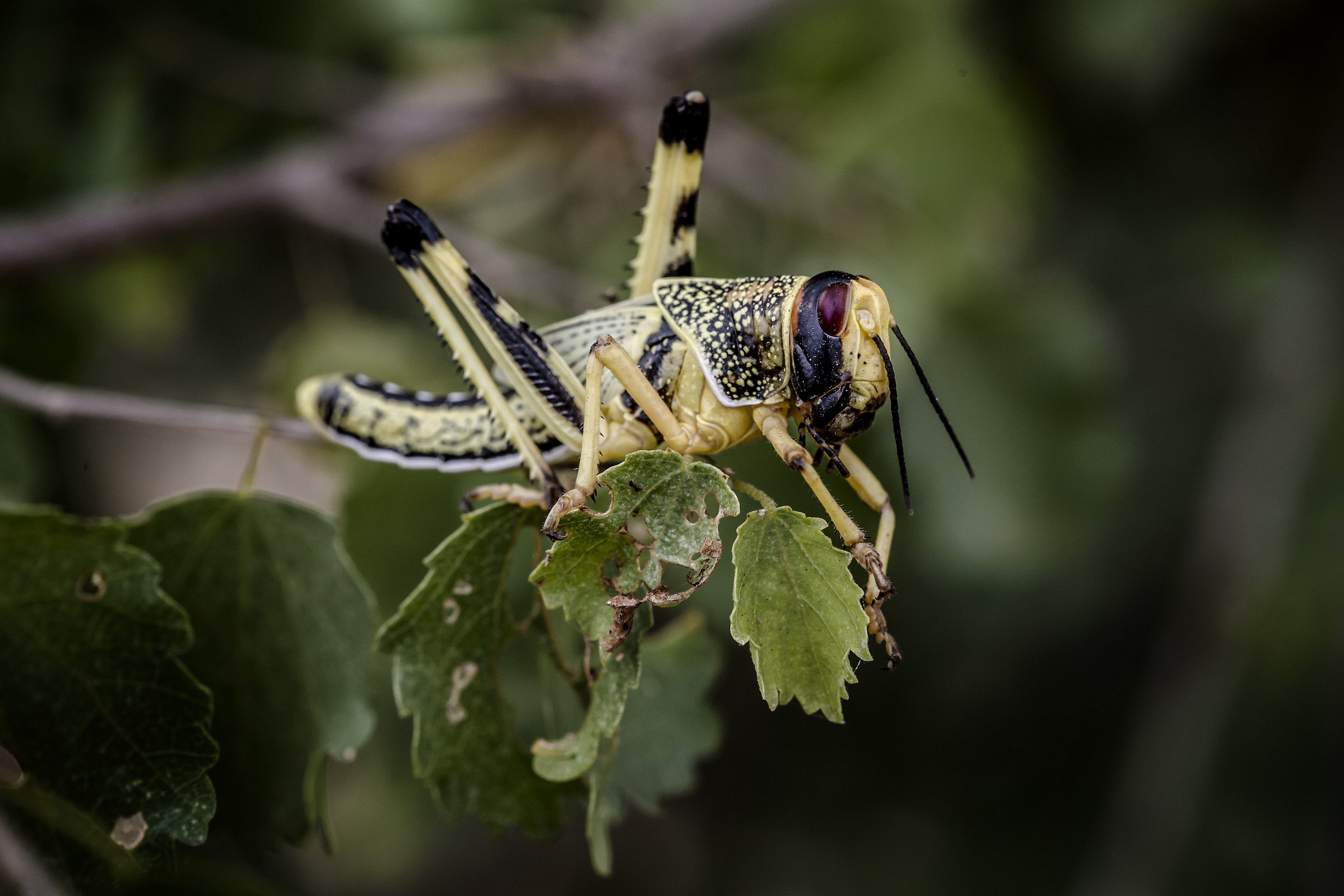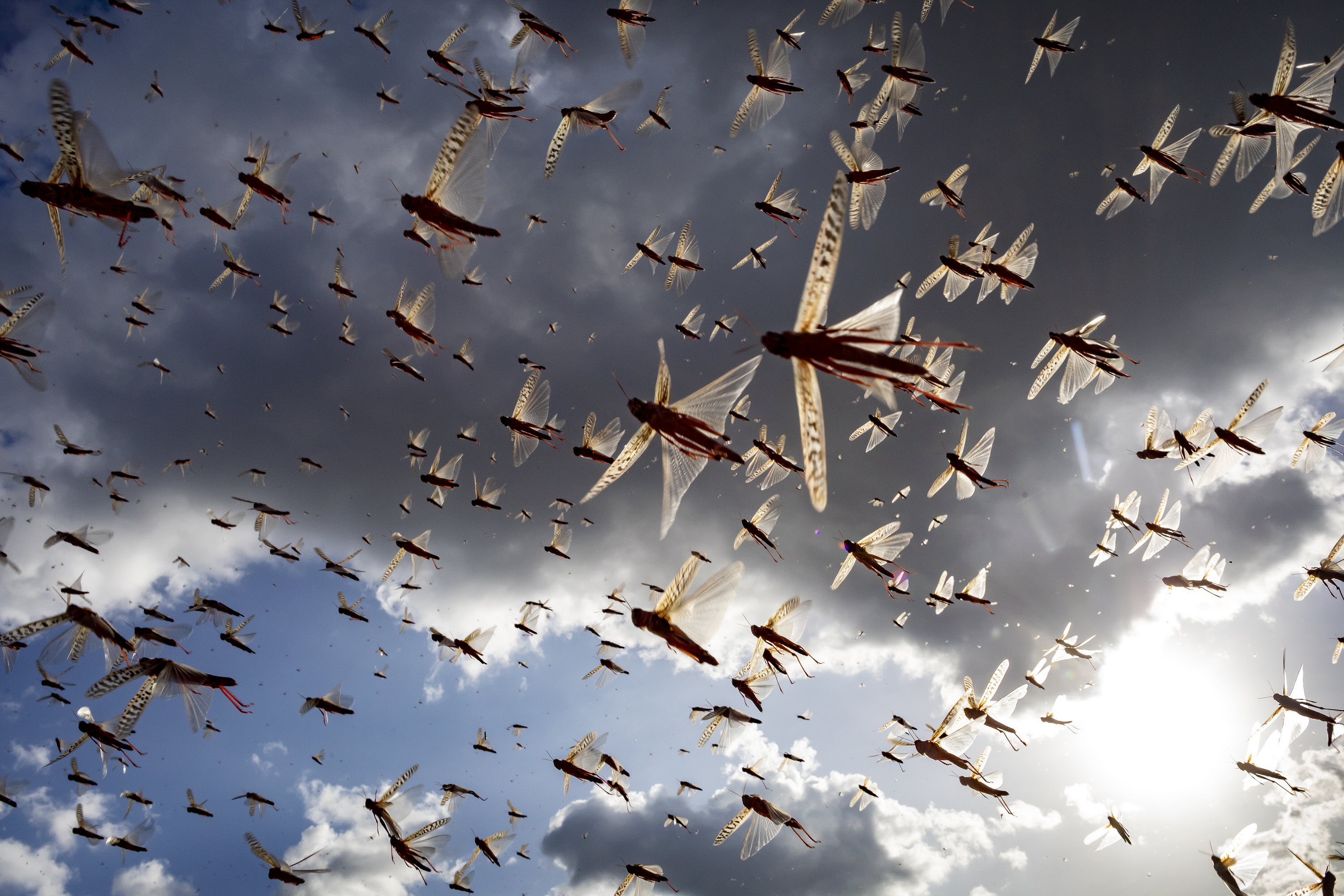Briefs
Latest updates of the locust situation

17 April 2024: seasonal precipitation predictions
17/04/2024
Overview:
- The latest seasonal dynamical models continue to suggest above-normal rainfall from eastern Africa across the Arabian Peninsula to northwest India in the coming months.
- The positive Indian Ocean Dipole (IOD) phase has increased dramatically. In addition, the Gulf of Aden and the Arabian Sea may experience heightened cyclone activity in May and June.
- Similar to last month, above-normal rainfall is expected during the spring in the interior of the Arabian Peninsula (Saudi Arabia, Yemen, Oman), southeast Iran, southwest Pakistan, and northern Somalia.
- In the summer, Sudan to Indo-Pakistan can expect above-average rainfall and favourable breeding conditions. India is expected to have a normal monsoon starting in June this year.
- In West Africa, above-normal rain is likely to be delayed until about August along the northern Sahel from Mauritania to Chad.

3 April 2024: hopper bands decline
03/04/2024
- Overview: The five Desert Locust outbreaks decreased along the Red Sea and Gulf of Aden coast in Egypt, Eritrea, Saudi Arabia, Somalia, and Sudan.
- Current situation: Second generation of hopper groups, bands, and immature adult groups declined.
- Control: Operations decreased by 50% in March compared to January.
- April–May: One generation of spring breeding will occur in Saudi Arabia and parts of northern Sudan and southern Egypt; May and June might see a rise in cyclone activity along the Gulf of Aden and Arabian Sea; consequently, countries must maintain survey and control efforts.

15 March 2024: expected above-normal rainfall
18/03/2024
- Latest models suggest widespread above-normal rainfall during the spring in the interior of Saudi Arabia, Yemen Gulf of Aden and interior, coast and interior of Oman, southeast Iran and southwest Pakistan, and perhaps northern Sudan Nile Valley; abnormal rains on the northern Red Sea coast of Saudi Arabia.
- Gulf of Aden and the Arabian Sea may experience heightened cyclone activity in May and June.
- Summer from Sudan to Pakistan/India expect above-average rainfall and favourable breeding conditions.
- Western Africa experiences rain starting in July in Chad, followed by Niger, Mali and Mauritania in August and September.

2 March 2024: Second-generation breeding
02/03/2024
- Overview: There a five Desert Locust outbreaks along the Red Sea and Gulf of Aden coast: Egypt, Eritrea, Saudi Arabia, Somalia, and Sudan.
- Current situation: Second generation of hopper groups, bands, and immature adult groups.
- Control: Operations decreased in February compared to January.
- March–April: Locusts will decrease because of control operations, diminished rainfall, and drying vegetation and limited small-scale breeding could occur in the spring; consequently, countries must maintain survey and control efforts.

5 February 2024: five outbreaks in Central Region
05/02/2024
- There a five Desert Locust outbreaks along the coast of the Red Sea and Gulf of Aden: Egypt, Eritrea, Saudi Arabia, Somalia, and Sudan.
- Current situation: Groups and swarms of the first winter breeding generation as well as the second generation of new hatching and hopper groups and bands.
- Control: Operations increased in January compared to December.
- February–March: Locusts are likely to decrease because of control operations, diminished rainfall, and drying vegetation in March, but countries must maintain survey and control efforts.

22 January 2024: second-generation breeding started
22/01/2024
- The four Desert Locust outbreaks that began in November continue to persist in Eritrea, Saudi Arabia, Somalia, and Sudan.
- The second generation of the winter breeding started this past week on the Red Sea and the Gulf of Aden coasts in southeast Egypt, Sudan, Eritrea, Saudi Arabia, northwest Somalia, and probably Yemen.
- Control operations continue during the first generation where there are mainly immature and mature adults, groups, and small swarms as well as some late instar hoppers, groups, and bands.
- The second generation will continue during February
and March when more rain is likely in the southern Red Sea and Gulf of Aden coasts and the interior of the Horn of
Africa.

5 January 2024: Central Region outbreaks continue
05/01/2024
- Current situation: Outbreaks persist with breeding, groups and bands in Egypt, Eritrea, Saudi Arabia, Somalia, Sudan; a few locusts in Mauritania, Western Sahara, Morocco, Algeria, Niger.
- Control: Increased fivefold in Egypt, Eritrea, Saudi Arabia, Somalia (only biopesticides), Sudan (some air); a few in Mauritania.
- January–March: second generation with breeding, hatching, groups and bands along parts of the Red Sea and the Gulf of Aden coasts.

5 December 2023: Central Region outbreaks
05/12/2023
- Current situation: Outbreaks developed, groups, bands, and breeding: Eritrea, Saudi Arabia, Somalia, Sudan.
- Current situation: The first generation of winter season (Nov–Jan) on the Red Sea and the Gulf of Aden coasts.
- Control: operations in Eritrea, Mauritania, Saudi Arabia, Somalia, Sudan.
- November–February: above-normal rains and perhaps a second generation of breeding (Feb–Apr) on the Red Sea and the Gulf of Aden coasts.

2 November 2023: Beginning of winter season
02/11/2023
- Current situation (breeding): Saudi Arabia, Sudan, Yemen.
- Current situation: The summer season has nearly finished in the northern Sahel from Mauritania to Sudan; the winter season is starting on the Red Sea and the Gulf of Aden coasts.
- Control: operations in Saudi Arabia, Sudan, Yemen.
- November–February: above normal rains in winter breeding areas for small-scale breeding in the Red Sea and the Gulf of Aden coasts (Egypt, Eritrea, Saudi Arabia, Somalia, Sudan, Yemen).

4 October 2023: Summer breeding
04/10/2023
- Current situation (breeding): Chad, Mauritania, Oman, Saudi Arabia, Sudan
- Current situation: A few swarms in Ethiopia, Sudan, Yemen; Groups in Oman, Saudi Arabia, Sudan; Adults in Chad, Egypt, Mauritania, Morocco, Niger, Pakistan, Somalia
- Control: small operations in Ethiopia, Oman, Saudi Arabia, Sudan
- October–November: above normal rains in summer breeding areas for small-scale breeding in northern Sahel (Mauritania to western Eritrea)
- Winter season: starts earlier than normal this year on both sides of the Red Sea and Gulf of Aden coast from October to February


